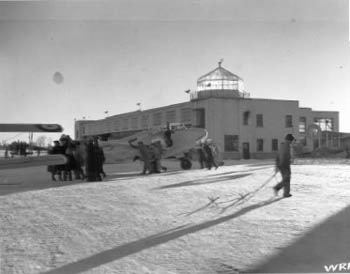Building 51
Recognized Federal Heritage Building
Quinte West, Ontario

General view
(© National Archives of Canada / Archives nationales du Canada, ca. 1939.)
Address :
CFB Trenton - Hangar Line - 8 Wing, Quinte West, Ontario
Recognition Statute:
Treasury Board Policy on Management of Real Property
Designation Date:
1991-01-10
Dates:
-
1931 to 1931
(Construction)
Event, Person, Organization:
-
Department of National Defence
(Architect)
Other Name(s):
-
Hangar 3
(Other Name)
-
Hangar Line No. 51
(Other Name)
Custodian:
National Defence
FHBRO Report Reference:
89-027
DFRP Number:
09540 00
Description of Historic Place
Building 51, also known as Hangar 3, is part of a hangar line located at the Canadian Forces Base (CFB) in Trenton. It is a large, rectangular hangar with an exterior clad in metal siding. The building has a flat roof and a stepped roofline on one elevation. Both regular and large size doors and windows are symmetrically arranged on the facades. The designation is confined to the footprint of the building.
Heritage Value
Building 51 is a Recognized Federal Heritage Building because of its historical associations, and its architectural and environmental value.
Historical Value
Building 51 is closely associated with the Royal Canadian Air Force (RCAF) at Trenton, and its important role during the Second World War as the Central Flying School for the British Commonwealth Air Training Plan (BCATP). It is also associated with the early development of the RCAF at Trenton, and as part of the service component represented by the hangar row, it was a key aspect in the success of the BCATP.
Architectural Value
Building 51 is valued for its good aesthetic and functional design. It was built to a standard architectural style and colour scheme as part of a distinct line of hangars dating from the early development phase of RCAF Trenton. Designed to house pre-Second World War aircraft used in the training of the RCAF operational unit as well as civilian pilots, its flat roof features double Warren trusses and provides unobstructed interior volumes.
Environmental Value
Building 51 is compatible with the present character of its military base setting at CFB Trenton. As part of a distinctive and unified hangar row, it is a familiar building on the base.
Sources: Marilyn E. Armstrong-Reynolds, Eight Buildings, Canadian Forces Base Trenton, Trenton, Ontario, Federal Heritage Buildings Review Office, Building Report, 89-027; Building 49, Hangar #5 and Building 51, Hangar #3, CFB Trenton, Trenton, Ontario, Heritage Character Statement, 89-027.
Character-Defining Elements
The character-defining elements of Building 51 should be respected.
Its good aesthetic and functional design and good materials and craftsmanship, for example: the flat-roof profile with a stepped profile on its west elevation; the regular pattern of windows; the double Warren truss system; the large, open interior.
The manner in which Building 51 is compatible with the present character of its military base setting at CFB Trenton and is a familiar building at the base, as evidenced by: its overall scale, massing and materials, which contribute to the distinctive and unified hangar row; its familiarity to those working on the base.
Heritage Character Statement
Disclaimer -
The heritage character statement was developed by FHBRO to explain the reasons for the designation of a federal heritage building and what it is about the building that makes it significant (the heritage character). It is a key reference document for anyone involved in planning interventions to federal heritage buildings and is used by FHBRO in their review of interventions.
Building 51, CFB Trenton, Ontario, was built in August 1931 and designed by the Engineering Services Branch of the Canadian Army. Building 49, built in 1935-36, was designed by the Royal Canadian Engineers. Both structures are owned by the Department of National Defence. See FHBRO Building Report 89-27.
Reasons for Designation
Buildings no. 51 and no. 49 were designated Recognized heritage buildings. Both buildings were designated because of RCAF Trenton's important role during World War II as the Central Flying School for the British Commonwealth Air Training Plan (BCATP) and because they are representative of the early development of RCAF Trenton.
Both structures, as part of the service component represented by hangar row, were a key aspect in the success of the BCATP.
Character Defining Elements
The heritage character of Buildings no. 51 and no. 49 is defined by their location as part of a distinct line of hangars dating from the early development phase of RCAF Trenton. Both structures were built according to a standard architectural style and colour scheme.
The clean and simple exterior form, the art deco detailing, the original windows and the standard stucco finish on Building 49 should be retained as should the interior space of the service area which is virtually unchanged.
The exterior of Building 51 has been extensively altered by the addition of metal siding. If future exterior alterations are to be undertaken, removal of the existing metal siding, reinstatement of the original stucco finish, the attractive window pattern and the hangar doors should be considered.
Buildings no. 51 and no. 49 contribute to the formation of a distinctive and unified hangar row. The visual line created by the hangar row should not be compromised.